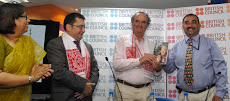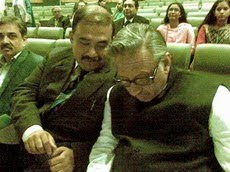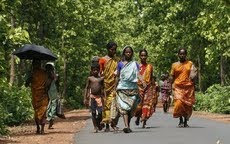[ The following is the Excerpts from Troubled Periphery : Crisis of India's Northeast ]
The Northeast has been seen as the problem child since the very inception of the Indian republic. It has also been South Asia's mostenduring theatre of separatist guerrilla war, a region where armed action has usually been the first, rather than the last, option ofpolitical protest.  But none of these guerrilla campaigns have led to secession-like East Pakistan breaking off to become Bangladesh in 1971 or East Timor shedding off Indonesian yoke in 1999. Nor have these conflicts been as intensely violent as the separatist movements in Indian Kashmir and Punjab. Sixty years after the British departed from South Asia, none of the separatist movements in the northeast appear anywhere near their proclaimed goal of liberation from Indian rule. Nor does the separatist violence in the region threaten to spin out of control.
But none of these guerrilla campaigns have led to secession-like East Pakistan breaking off to become Bangladesh in 1971 or East Timor shedding off Indonesian yoke in 1999. Nor have these conflicts been as intensely violent as the separatist movements in Indian Kashmir and Punjab. Sixty years after the British departed from South Asia, none of the separatist movements in the northeast appear anywhere near their proclaimed goal of liberation from Indian rule. Nor does the separatist violence in the region threaten to spin out of control. That raises a key question that historian David Ludden once tried toraise while summing up the deliberation of a three-day seminar at Delhi's elite Jawaharlal Nehru University whether the Northeast challenges the separation of the colonial from the national. Or whether it raises the possibility of reorganization of space by opening up India's boundaries. Opinion is divided. Historian Aditya Mukherjee, in his keynote address at a Guwahati seminar( 29-30 March,2009), challenged Ludden and his likes by insisting that the Indian nation evolved out a national movement against imperialism and did notseek to impose, like in the West, the master narrative of the majorityon the smaller minorities in the process of nation building. Mukherjee insisted that the Indian democracy is unique and not coercive and can accommodate the aspirations of almost any minority group. In the same seminar, Professor Javed Alam, chairman of the Indian Council of Social Science Research, carried the argument forward by saying a new phase of democratic assertion involving smaller minorities and hitherto-marginalised groups in the new century is now opening up new vistas of Indian democracy.
That raises a key question that historian David Ludden once tried toraise while summing up the deliberation of a three-day seminar at Delhi's elite Jawaharlal Nehru University whether the Northeast challenges the separation of the colonial from the national. Or whether it raises the possibility of reorganization of space by opening up India's boundaries. Opinion is divided. Historian Aditya Mukherjee, in his keynote address at a Guwahati seminar( 29-30 March,2009), challenged Ludden and his likes by insisting that the Indian nation evolved out a national movement against imperialism and did notseek to impose, like in the West, the master narrative of the majorityon the smaller minorities in the process of nation building. Mukherjee insisted that the Indian democracy is unique and not coercive and can accommodate the aspirations of almost any minority group. In the same seminar, Professor Javed Alam, chairman of the Indian Council of Social Science Research, carried the argument forward by saying a new phase of democratic assertion involving smaller minorities and hitherto-marginalised groups in the new century is now opening up new vistas of Indian democracy. But scholars from the northeast contested these 'mainland' scholars by saying their experience in the Northeast was different. They point to the endless festering conflicts, which have spread to new areas ofthe region, leading to sustained deployment of Indian army and federal paramilitary forces on 'internal security duties', that, in turn, has militarised rather than democratized the social and political space in the Northeast. These troops are deployed often against well-armed and relatively well-trained insurgents adept at the use of the hillterrain and often willing to use modern urban terror tactics for the shock effect.
But scholars from the northeast contested these 'mainland' scholars by saying their experience in the Northeast was different. They point to the endless festering conflicts, which have spread to new areas ofthe region, leading to sustained deployment of Indian army and federal paramilitary forces on 'internal security duties', that, in turn, has militarised rather than democratized the social and political space in the Northeast. These troops are deployed often against well-armed and relatively well-trained insurgents adept at the use of the hillterrain and often willing to use modern urban terror tactics for the shock effect. It must be said that the military deployment has aimed at neutralizing the strike power of the insurgents to force them to the table, rather than seeking their complete destruction. So the rebel groups have also not been forced to launch an all-out do-or-die secessionist campaign, as the Awami League was compelled to do in East Pakistan in 1971. The space for accommodation, resource transfer and power-sharing that the Indian state offered to recalcitrant groups has helped India controlthe insurgencies and often co-opt their leadership. Now some wouldcall co-option a democratic exercise. That's where the debate goes to a point of no resolution. What many see as a bonafide and well-meant state effort to win over the rebel leadership to join the mainstream is seen by many others, specially in the Northeast, as a malafide and devious co-option process, a buying of loyalties by use of force, monetary in ducements and promise of office rather than securing it by voluntary and fair means. Interestingly, the insurgencies have only multiplied in northeast India. Whenever a rebel group has signed an accord with the Indian government in a particular state, the void has been quickly filled by other groups, reviving the familiar allegations of betrayal, neglect and alienation.
It must be said that the military deployment has aimed at neutralizing the strike power of the insurgents to force them to the table, rather than seeking their complete destruction. So the rebel groups have also not been forced to launch an all-out do-or-die secessionist campaign, as the Awami League was compelled to do in East Pakistan in 1971. The space for accommodation, resource transfer and power-sharing that the Indian state offered to recalcitrant groups has helped India controlthe insurgencies and often co-opt their leadership. Now some wouldcall co-option a democratic exercise. That's where the debate goes to a point of no resolution. What many see as a bonafide and well-meant state effort to win over the rebel leadership to join the mainstream is seen by many others, specially in the Northeast, as a malafide and devious co-option process, a buying of loyalties by use of force, monetary in ducements and promise of office rather than securing it by voluntary and fair means. Interestingly, the insurgencies have only multiplied in northeast India. Whenever a rebel group has signed an accord with the Indian government in a particular state, the void has been quickly filled by other groups, reviving the familiar allegations of betrayal, neglect and alienation. The South Asia Terrorism Portal (SATP) in 2006 counted 109 rebel groups in northeast India-only the state of Arunachal Pradesh was found to be without one, though Naga rebel groups were active in the state. Interestingly, only a few of these are officially banned. Of the 40 rebel groups in Manipur, only six were banned under India's Unlawful Activities Prevention Act. And of the 34 in the neighbouring state of Assam, only two were banned. A good number of these groups are described as "inactive" but some such groups have been revived from time to time. Since post-colonial India has been ever willing to create new states or autonomous units to fulfi l the aspirations of the battling ethnicities, the quest for an "ethnic homeland" and insurgent radicalism as a means to achieve it has become the familiar political grammar of the region. So insurgencies never peter out in the Northeast, even though insurgents do. Phizo faded away to make way for a Muivah in the Naga rebel space,but soon there was a Khaplang to challenge Muivah. If Dasarath Dev walked straight into the Indian parliament from the tribal guerrilla bases in Tripura, elected in absentia, there was a Bijoy Hrangkhawl to take his place in the jungle, alleging CPIM betrayal of the tribal cause.
The South Asia Terrorism Portal (SATP) in 2006 counted 109 rebel groups in northeast India-only the state of Arunachal Pradesh was found to be without one, though Naga rebel groups were active in the state. Interestingly, only a few of these are officially banned. Of the 40 rebel groups in Manipur, only six were banned under India's Unlawful Activities Prevention Act. And of the 34 in the neighbouring state of Assam, only two were banned. A good number of these groups are described as "inactive" but some such groups have been revived from time to time. Since post-colonial India has been ever willing to create new states or autonomous units to fulfi l the aspirations of the battling ethnicities, the quest for an "ethnic homeland" and insurgent radicalism as a means to achieve it has become the familiar political grammar of the region. So insurgencies never peter out in the Northeast, even though insurgents do. Phizo faded away to make way for a Muivah in the Naga rebel space,but soon there was a Khaplang to challenge Muivah. If Dasarath Dev walked straight into the Indian parliament from the tribal guerrilla bases in Tripura, elected in absentia, there was a Bijoy Hrangkhawl to take his place in the jungle, alleging CPIM betrayal of the tribal cause.  And when Hrangkhawl called it a day after ten years of blood-letting, there was a Ranjit Debbarma and a Biswamohan Debbarma, ready to take his place. Even in Mizoram, where no Mizo rebel leader took to the jungles after the 1986 accord, smaller ethnic groups like the Brus and the Hmars have taken to armed struggle in the last two decades, looking for their own acre of green grass. Throughout the last six decades, the same drama has been repeated, state after state. As successive Indian governments tried to nationalise the political space in the Northeast by pushing ahead with mainstreaming efforts, the struggling ethnicities of the region continued to challenge the 'nation-building processes', stretching the limits of constitutional politics. But these ethnic groups also fought amongst themselves, often as viciously as they fought India, drawing daggers over scarce resources and conflicting visions of homelands. In such a situation, where crisis also provided opportunity to the Indian state to use the four principles of real politicks tatecraft propounded by the great Kautilya, the man who helped Chandragupta build India's first trans-regional empire just after Alexander's invasion. Sham(Reconciliation), Dam(Monetary Inducement), Danda(Force) and Bhed(Split) - the four principles of Kautilyan statecrafthave all been used in varying mix to control and contain the violent movements in the northeast.
And when Hrangkhawl called it a day after ten years of blood-letting, there was a Ranjit Debbarma and a Biswamohan Debbarma, ready to take his place. Even in Mizoram, where no Mizo rebel leader took to the jungles after the 1986 accord, smaller ethnic groups like the Brus and the Hmars have taken to armed struggle in the last two decades, looking for their own acre of green grass. Throughout the last six decades, the same drama has been repeated, state after state. As successive Indian governments tried to nationalise the political space in the Northeast by pushing ahead with mainstreaming efforts, the struggling ethnicities of the region continued to challenge the 'nation-building processes', stretching the limits of constitutional politics. But these ethnic groups also fought amongst themselves, often as viciously as they fought India, drawing daggers over scarce resources and conflicting visions of homelands. In such a situation, where crisis also provided opportunity to the Indian state to use the four principles of real politicks tatecraft propounded by the great Kautilya, the man who helped Chandragupta build India's first trans-regional empire just after Alexander's invasion. Sham(Reconciliation), Dam(Monetary Inducement), Danda(Force) and Bhed(Split) - the four principles of Kautilyan statecrafthave all been used in varying mix to control and contain the violent movements in the northeast.But unlike in many other post colonial states like military ruled Pakistan and Burma, the Indian government have not displayed an over-reliance on force. After the initial military operation in the northeast had taken the sting out of a rebel movement, an 'Operation Bajrang' or an 'Operation Rhino' has been quickly followed up by offers of negotiations and liberal doses of federal largesse, all aimed at co-option. If nothing worked, intelligence agencies have quickly moved in to divide the rebel groups. That But with draconian lawslike the controversial Armed Forces Special Powers Act always available to security forces for handling a breakdown of public order, the architechure of militarisation remained in place. Covert intelligence operations only made the scenario more murky, bloody and devious.
။ Photos : Indrajit Dutta
( Subir Bhaumik is the BBC's East India Correspondent and a known South Asian affairs observer )









